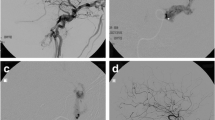Summary
A series of 32 patients with aneuryms in the cavernous sinus region is presented. All of them have been operated upon through an intradural pterional approach and the aneurysms directly attacked. Only in 6 patients was the complete dissection of the internal carotid artery and of the aneurysm impossible because of the size of the aneurysms. In these cases the aneurysm has been traped by ligation of the internal carotid artery in the neck and its supraclinoid course and at the same time and extracranial intracranial anastomosis performed. One patient died from massive cerebral infarction after a trapping procedure and another died from a transoperative haemorrhage; another two developed a moderate hemiparesis which resolved within the first six postoperative weeks, and in two patients a preoperative severe visual impairment progressed postoperatively to complete visual loss. All others had a complete resolution of their preoperative symptoms and remained well.
The advantages and disadvantages of the different approaches to intracavernous carotid artery aneurysms are discussed and the related literature reviewed.
Similar content being viewed by others
References
Baumgartner WA, Silverberg GD, Ream AK, Jamieson SW, Tarabek J, Reitz BA (1983) Reappraisal of cardiopulmonary bypass with deep hypothermia and circulatory arrest for complex neurosurgical operations. Surgery 94: 242–249
Diaz FG, Ausman JI, Pearce J (1982) Ischemic complications following internal carotid occlusions combined with intracranial-extracranial anastomosis. Neurosurg 10: 563–570
Dolenc VV (1983) A combined epi-and subdural direct approach to carotid ophthalmic artery aneurysms. J Neurosurg 62: 667–672
Dolenc VV (1983) Direct microsurgical repair of intracavernous vascular lesions. J Neurosurg 58: 824–831
Drake CG: Giant intracranial aneurysms. Experience with surgical treatment in 174 patients. Clin Neurosurg 26: 12–95
Parkinson D (1973) Carotid cavernous fistula: direct repair with preservation of the carotid artery. Technical note. J Neurosurg 38: 99–106
Roski RA, Spetzler RF, Nulsen FE (1981) Late complications of carotid ligation in the treatment of intracranial aneurysms. J Neurosurg 54: 583–587
Spetzler RF, Roski RA, Schuster H, Takaska Y (1980) The role of EC-IC in the treatment of giant intracranial aneurysms. Neurosurg Res 2: 345–359
Sundt TM, Piepgras DG, Marsh WR, Fode NC (1986) Saphenous vein bypass grafts for giant aneurysms and intracranial occlusive disease. J Neurosurg 65: 439–450
Wilkins RH (1985) Trigeminal neuralgia: Introduction in Neurosurgery. Wilkins RH, Rengachari SS (eds) McGraw-Hill, pp 2337–2344
Author information
Authors and Affiliations
Rights and permissions
About this article
Cite this article
Diaz, F.G., Ohaegbulam, S., Dujovny, M. et al. Surgical management of aneurysms in the cavernous sinus. Acta neurochir 91, 25–28 (1988). https://doi.org/10.1007/BF01400523
Issue Date:
DOI: https://doi.org/10.1007/BF01400523




